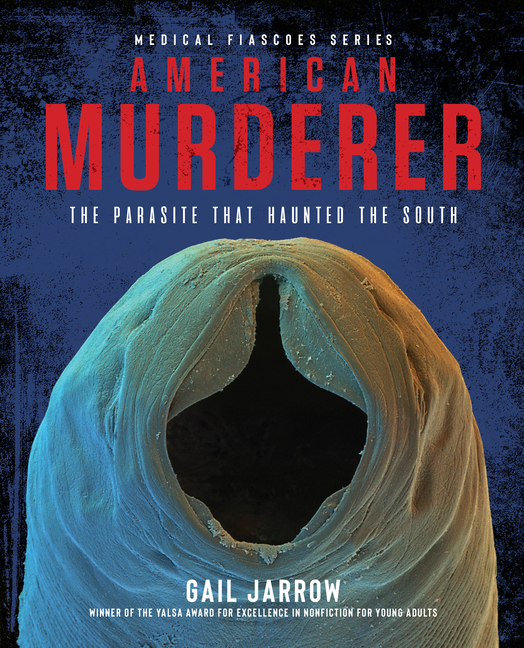Book Descriptions
for American Murderer by Gail Jarrow
From Cooperative Children's Book Center (CCBC)
The newest installment of Jarrow’s “Medical Fiascoes” series delves into the devastating impact and attempted eradication of hookworm in the American South. The species in question, Necator americanus, or “American murderer,” was discovered by epidemiologist Charles Wardell Stiles. Thriving in warm climates, the hookworm larva enters the body via the skin—often of bare feet—and travels in the bloodstream to the lungs, where it exits the capillaries and is swallowed. Once in the small intestine, it attaches itself and grows to maturity on the blood of its host. Dubbed “the lazy germ” by journalists, hookworm caused debilitating weakness and stunted growth in its victims. Because the eggs are expelled in feces, the primary cause of its spread in poor, rural Southern communities in the 19th and early 20th centuries was poorly built outhouses. In 1909, the Rockefeller Sanitary Commission was established to educate, test, and treat the public as well as advocate for improved sanitation systems. Facing resistance from the public, journalists, and even medical professionals along the way, their efforts were moderately successful. Like the others in the series, this account provides necessary social and cultural context alongside robust (and horrifying) medical and scientific information. (Age 11 and older)
CCBC Choices 2023. © Cooperative Children's Book Center, Univ. of Wisconsin - Madison, 2023. Used with permission.
From the Publisher
Included on NPR's 2022 "Books We Love" List
Finalist, 2023 YALSA Award for Excellence in Nonfiction
ALSC Notable Children's Book
What made workers in the American South so tired and feeble during the 19th and early 20th centuries? This exciting medical mystery uncovers the secrets of the parasite hookworm, commonly known as the “American Murderer,” and is the latest title in Gail Jarrow’s (YALSA Excellence in Nonfiction for Young Adults award-winning author) Medical Fiascoes series.
Imagine microscopic worms living in the soil. They enter your body through your bare feet, travel to your intestines, and stay there for years sucking your blood like vampires. You feel exhausted. You get sick easily. It sounds like a nightmare, but that’s what happened in the American South during the 1800s and early 1900s.
Doctors never guessed that hookworms were making patients ill, but zoologist Charles Stiles knew better. Working with one of the first public health organizations, he and his colleagues treated the sick and showed Southerners how to protect themselves by wearing shoes and using outhouses so that the worms didn’t spread. Although hookworm was eventually controlled in the US, the parasite remains a serious health problem throughout the world. The topic of this STEM book remains relevant and will fascinate readers interested in medicine, science, history—and gross stories about bloodsucking creatures.
Finalist, 2023 YALSA Award for Excellence in Nonfiction
ALSC Notable Children's Book
What made workers in the American South so tired and feeble during the 19th and early 20th centuries? This exciting medical mystery uncovers the secrets of the parasite hookworm, commonly known as the “American Murderer,” and is the latest title in Gail Jarrow’s (YALSA Excellence in Nonfiction for Young Adults award-winning author) Medical Fiascoes series.
Imagine microscopic worms living in the soil. They enter your body through your bare feet, travel to your intestines, and stay there for years sucking your blood like vampires. You feel exhausted. You get sick easily. It sounds like a nightmare, but that’s what happened in the American South during the 1800s and early 1900s.
Doctors never guessed that hookworms were making patients ill, but zoologist Charles Stiles knew better. Working with one of the first public health organizations, he and his colleagues treated the sick and showed Southerners how to protect themselves by wearing shoes and using outhouses so that the worms didn’t spread. Although hookworm was eventually controlled in the US, the parasite remains a serious health problem throughout the world. The topic of this STEM book remains relevant and will fascinate readers interested in medicine, science, history—and gross stories about bloodsucking creatures.
Publisher description retrieved from Google Books.


